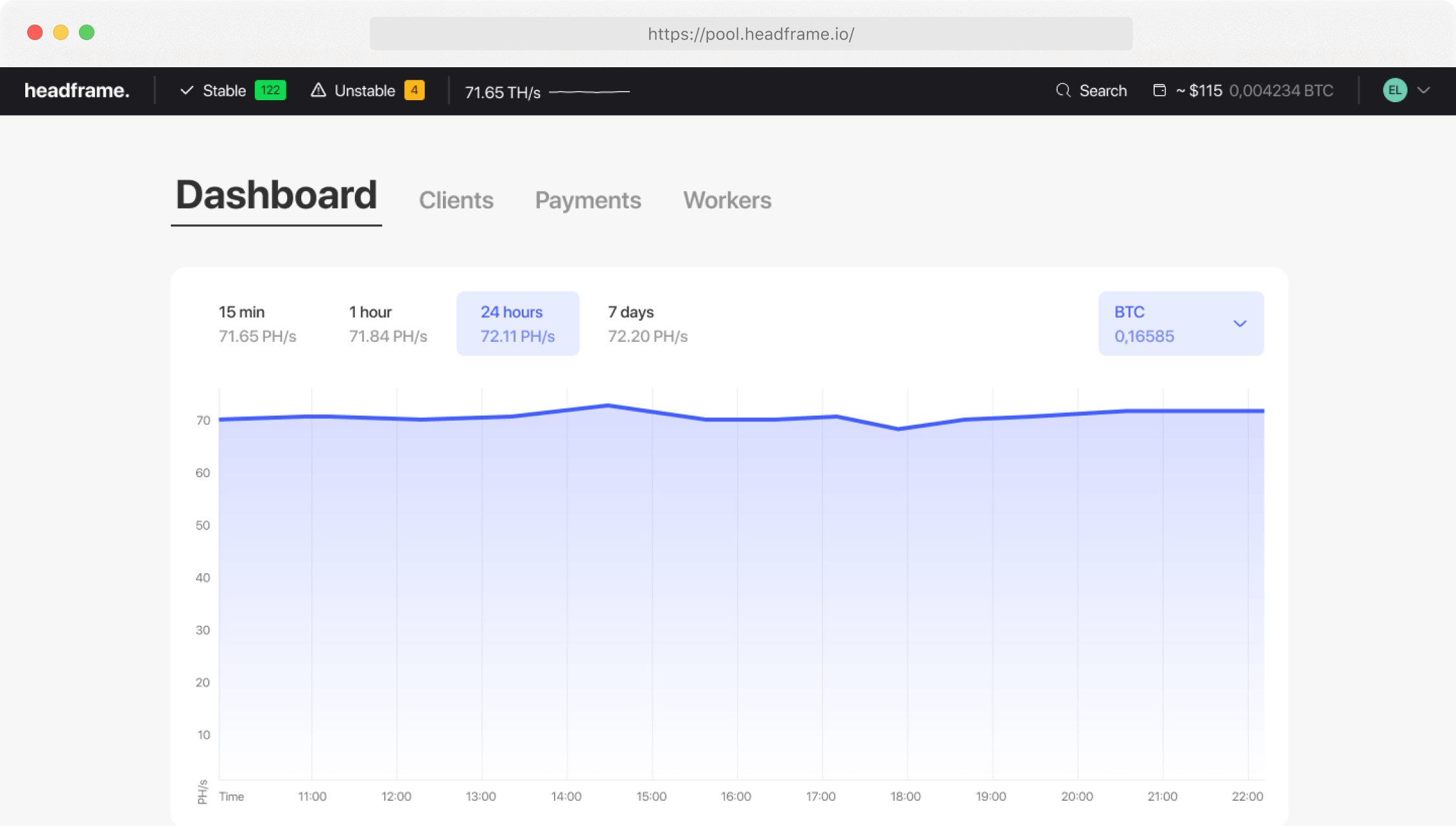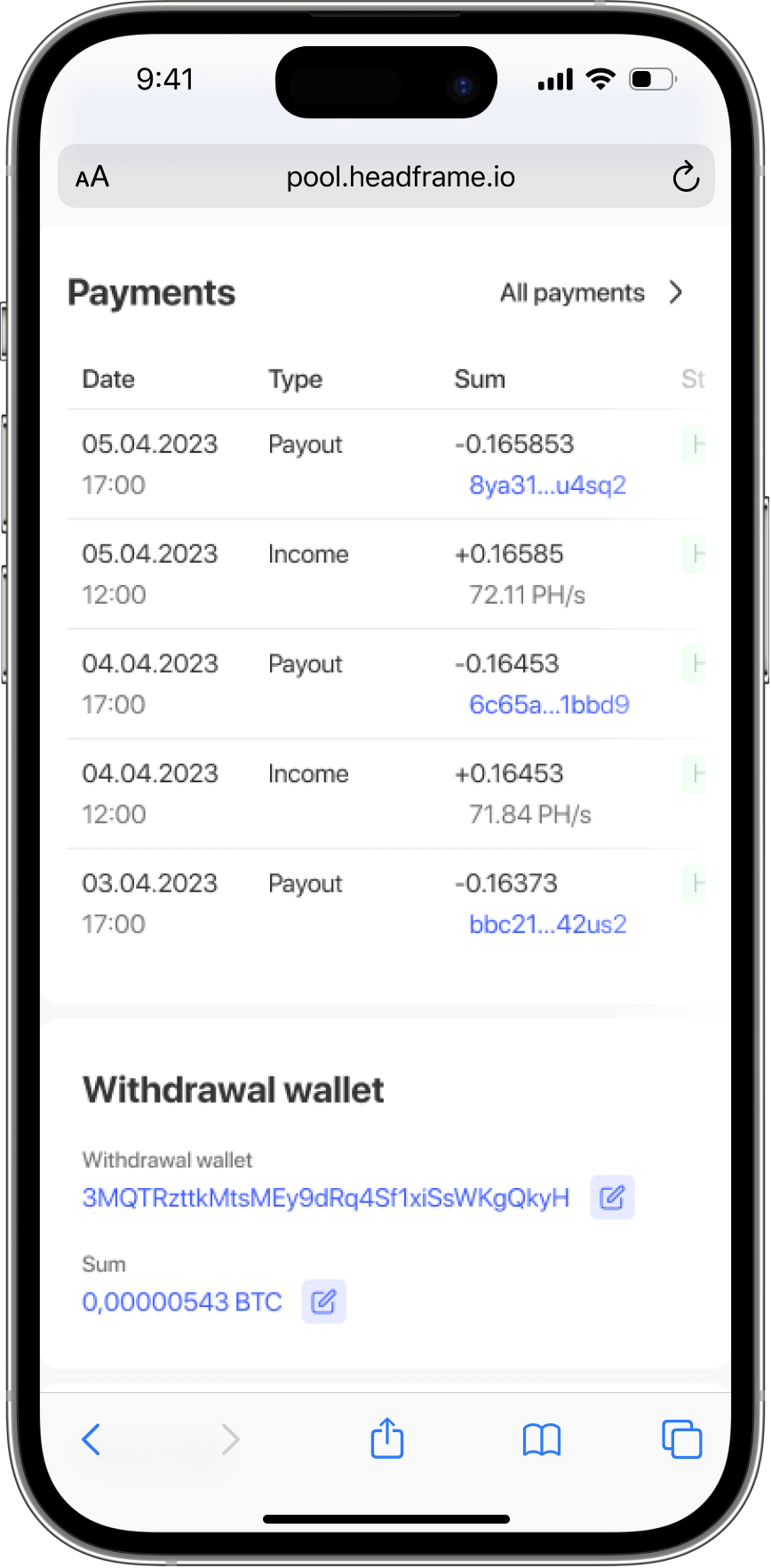
Top Best ASICs for Bitcoin mining in 2023
- Cryptocurrency mining for beginners
- Types of mining
- What can be used for cryptocurrency mining?
- How to make money on cryptocurrency mining from scratch: the basics of mining
- Risks of mining
- FAQs
Cryptocurrency mining for beginners
Earn more money with Headframe
Join a mining pool and get the best profitability in mining. Already more than 10,000 miners trust Headframe.
Cryptocurrency mining can seem like a daunting task for beginners, especially with the rapid changes and advancements in technology. However, with the right knowledge and tools, it can be a promising venture. Here’s a basic guide to help you get started with cryptocurrency mining in 2023.
Cryptocurrency mining is the process of verifying transactions on a cryptocurrency network and adding them to the blockchain, a public registry of all past transactions. Miners use powerful computers to solve complex math problems that validate transactions. Once the problem is solved, the miner adds the block of transactions to the blockchain and receives a certain amount of cryptocurrency as a reward.
What you will need for cryptocurrency mining:
Hardware: First, you will need a computer. In the early days of Bitcoin, it was possible to mine with a simple computer. However, as the complexity of mining increases, more powerful hardware is required. Nowadays, most miners use either ASICs (programmable integrated circuits specialized for mining specific cryptocurrencies) or GPUs (graphics processing units). ASICs are designed specifically for mining specific cryptocurrencies, which makes them very efficient, but they are also more expensive and less versatile than GPUs.
Software: You will also need mining software that runs on your hardware. This software connects your hardware to the blockchain and, if necessary, to a mining pool. There are many different types of mining software, so you will need to do some research to find the one that is right for you.
Cryptocurrency Wallet: You will need a digital wallet to store the cryptocurrency that you get from mining. There are many different types of wallets, including online wallets, mobile wallets, desktop wallets, and hardware wallets. Each has its own advantages and disadvantages, so you need to choose the one that works best for you.
Stable internet connection: Mining requires a constant internet connection to synchronize with the blockchain.
Participation in a mining pool (optional): Mining pools are groups of miners who pool their computing resources for more efficient mining. When a pool mines a block, the reward is divided among its members based on the amount of computing power they have contributed.
Electricity: Mining consumes a large amount of electricity. The cost of electricity in your area can significantly affect your potential profit.
By understanding these basics and ensuring you have the right components in place, you can start mining cryptocurrencies with confidence. Remember to stay up-to-date, adapt to changes in the industry, and regularly evaluate your mining activities to maximize potential profits.
Types of mining
Cryptocurrency mining can be done in a variety of ways, each with its own advantages and disadvantages.
Here is a comparison table that outlines the key differences between the different types of cryptocurrency mining:
| TYPE OF MAINING | DESCRIPTION | PLUSES | MINUSES |
| Solo mining | Independent mining using your own resources. | All mined cryptocurrencies go directly to the miner. | High level of complexity; requires significant computational resources; potential lack of revenue if block is not mined. |
| Pool mining | Multiple miners pool their computing resources to increase the chances of mining a block. | A better chance of getting consistent, albeit smaller, rewards. | Awards must be distributed to pool members. |
| CPU/GPU mining | Using a computer’s processor (CPU) or graphics card (GPU) for mining. | Available to individuals; GPU mining can be lucrative. | CPU mining is largely inefficient; both types of mining can lead to high energy costs and potential damage to equipment. |
| Mining farms | Large-scale operations with multiple high-performance computers dedicated to mining. | High efficiency and profitability potential. | Requires significant investment; high energy costs; cooling and space requirements. |
| Cloud mining | Rent mining equipment from a cloud mining provider. | No need to maintain your own equipment; a passive form of income. | Potential for fraud; lower profit margins due to rent and operating expenses. |
| Mining on a smartphone | Mining using a smartphone. | Available; no additional equipment required. | Not profitable due to limited processing power; can quickly drain the battery and cause the device to overheat. |
Please note that the profitability of each type of mining can vary greatly depending on factors such as the specific cryptocurrency you are mining, the cost of electricity, the current price of the cryptocurrency, and more. Always do your own research before deciding on a mining strategy.
What can I use to mine cryptocurrency?
Cryptocurrency mining requires specialized equipment to solve the complex mathematical problems that validate transactions on the blockchain. Here are the main types of hardware that can be used for cryptocurrency mining:
- CPU (Central Processing Unit)
In the early days of Bitcoin, CPUs were used for mining. However, as the complexity of mining increased, CPUs became less efficient. Today, CPU mining is usually only used for less popular or newer cryptocurrencies.
- GPU (Graphics Processing Unit)
Graphics processing units (GPUs) are more powerful than CPUs and can perform more calculations per second, making them a popular choice for mining. They are especially good for mining cryptocurrencies that use algorithms that are resistant to ASIC mining, such as Ethereum.
- ASIC (Specialized Integrated Circuit).
ASICs are specifically designed for mining specific cryptocurrencies, making them extremely efficient. They are the most powerful and fastest type of mining equipment, but they are also the most expensive. ASIC miners are often used to mine Bitcoin and other cryptocurrencies that use the SHA-256 algorithm.
- FPGA (Programmable Arbitrary Structure Graphics Array)
An FPGA is a type of hardware that can be programmed to perform certain tasks, similar to an ASIC. However, unlike ASICs, they can be reprogrammed if the mining algorithm changes. FPGAs are more efficient than CPUs and GPUs, but less powerful than ASICs.
- Mining farms
A mining farm is a computer system used for mining cryptocurrency. Mining farms often have multiple GPUs to increase power and efficiency.
- Cloud mining
If you don’t want to invest in your own equipment, you can use cloud mining services. These services rent the mining equipment and perform the mining for you. However, they often come with high fees and potential security risks.
Keep in mind that the type of equipment you choose depends on several factors, including the cryptocurrency you want to mine, your budget, and your technical skills.
How to make money mining cryptocurrencies from scratch: the basics of mining
Making money mining cryptocurrency from scratch can seem like a daunting task, but with the right information and tools, it can be a very lucrative endeavor. Here’s a detailed guide to the basics of mining to help you get started:
Step 1: Choosing a cryptocurrency
The first thing you need to do is decide which cryptocurrency you want to mine. Some cryptocurrencies are easier to mine than others, and the one that is best for you depends on your specific circumstances. Bitcoin is the most well-known, but there are many other options including Ethereum, Litecoin, and many others.
Step 2: Prepare your equipment
Depending on the cryptocurrency you choose, you will need the appropriate hardware. This could be a CPU, GPU, ASIC, or even a specialized mining rig. Remember that the more powerful your equipment is, the more likely you will be able to solve the math problems and earn cryptocurrency.
Step 3: Software Installation
Next, you need to choose your mining software. This software will manage your hardware and perform the mining. The appropriate software will depend on your hardware and the cryptocurrency you choose. Some of the popular options include CGMiner, BFGMiner, and EasyMiner.
Step 4: Create a wallet
Before you start mining, you need a digital wallet to store your cryptocurrency. There are many types of wallets to choose from, including online wallets, software wallets, and hardware wallets. Be sure to choose a secure wallet as it will store your hard earned cryptocurrency.
Step 5: Start mining
Now you’re ready to start mining. Open your mining software, enter your digital wallet address and start your hardware. Your computer will now start solving complex math problems and when it solves one of them, you will be rewarded with cryptocurrency.
Step 6: Consider joining a mining pool
Mining alone can be challenging, especially if you’re just starting out. That’s why many miners join mining pools, where they pool their computing resources with others to increase their chances of earning rewards. When a pool mines a block, the reward is divided among the pool members according to the amount of computing power they contributed.
Risks of mining
Cryptocurrency mining in 2023, like any other investment venture, involves certain risks. Here are some of them:
- Cryptocurrency price fluctuations: Cryptocurrency prices can fluctuate significantly. If the price of the cryptocurrency you are mining drops, your profits will also drop. In some cases, if the price drops too low, mining may become unprofitable.
- High electricity costs: Cryptocurrency mining requires a lot of electricity. In some places, the cost of electricity can be so high that it will eat up all of your mining profits.
- Mining equipment: Mining equipment can be expensive, and purchasing it can require a significant initial investment. In addition, mining equipment becomes obsolete quickly as manufacturers are constantly releasing new, more efficient models.
- Regulatory risks: Governments around the world treat cryptocurrencies differently. Cryptocurrency mining may be illegal in some countries, while in others it may be highly regulated. This can create legal risks for miners.
- Security Risks: Mining cryptocurrency can also expose you to security risks. Hackers may try to gain access to your mining equipment or your cryptocurrency wallet.
It’s important to remember that cryptocurrency mining is not a quick way to get rich. It requires careful planning, research, and understanding of the cryptocurrency market. If you consider all of these risks and are prepared for them, cryptocurrency mining can be a very lucrative endeavor.
FAQs
What is needed for cryptocurrency mining?
To mine cryptocurrency you will need specialized hardware (CPU, GPU, ASIC, FPGA or a mining farm), mining software, a cryptocurrency wallet to store your earned coins, a stable internet connection and access to electricity. You may also consider joining a mining pool to increase your chances of earning rewards.
Mining farm: where do I start?
Getting started with a mining farm starts with planning. You need to determine what cryptocurrency you want to mine and choose the right equipment based on that. You also need to consider power and cooling costs, as well as a place to house your farm. Once you have purchased and set up your equipment, you can start mining.
What types of mining are there and what are their characteristics?
There are different types of mining, including solo mining, pool mining, CPU/GPU mining, farm mining, cloud mining, and smartphone mining. Each has its own advantages and disadvantages, and choosing a particular type of mining depends on many factors, including your budget, technical skills, and the cryptocurrency you choose.
How to start earning money from cryptocurrency mining from scratch?
To start earning from cryptocurrency mining from scratch, you first need to choose a cryptocurrency to mine, then purchase the right hardware and install the mining software. After that, you should set up a digital wallet to store your cryptocurrency and finally start mining. You can also consider joining a mining pool to increase your chances of reaping the rewards.


